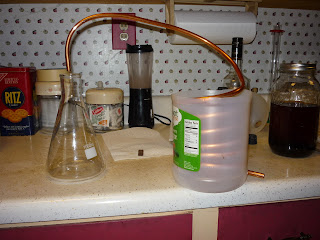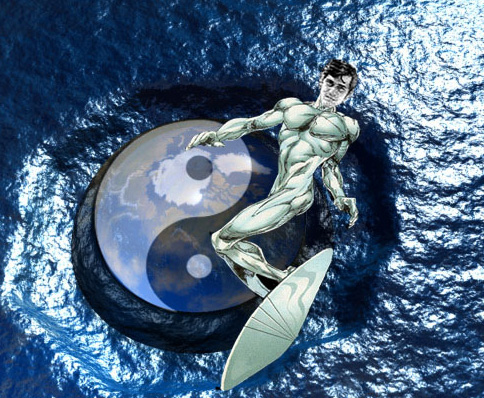I used to consider coffee as a substitute beverage after the British imposed their tea tax back in 1700's colonial America. It seems coffee has been around since 13th century Ethiopia. Legend has it that the original coffee tree was discovered by an Ethiopian goat herder when he saw the goats dancing on their hind legs after eating the fruit. After they learned to dry, roast, grind, and brew the beans into a beverage, coffee became Ethiopia's national treasure and the world's obsession.
Coffee roasting, grinding and brewing was traditionally done at home or wherever coffee was served, and the process was no more complicated than making tea. Green coffee beans had a reasonably long shelf life, were available, and the cost was next to nothing.
Then someone came up with the idea of roasting the beans in bulk and putting a label on it and fresh roasted coffee became a thing of the past. To streamline the process further, factories began grinding the coffee beans so all you needed to make coffee was water and some kind of heat source. By the time automatic drip coffee makers became a household standard, the art and science of producing great coffee was lost, and for the majority of coffee drinkers, drinking the corporate black stuff became more of a habit than the obsession it once was.
Two weeks after coffee is roasted it begins to go downhill fast. It's a safe bet that all the coffee you'll find in any supermarket, gourmet or not, has been warehoused for months before it got to the shelf, rendering it coffee in name only.
Like most people, I thought fresh ground was the key to better coffee but grinding dead beans just gives you dead ground coffee. This explains why the free coffee I had at the Maxwell House coffee plant in Hoboken, New Jersey was the best tasting coffee I ever had before. Fresh roasting, no matter where the coffee came from or what grade, makes a big difference. Just as big a difference is how it's brewed.
I used to think the best coffee maker on the market was an Elektra espresso machine with a price tag starting at $1500 for individual use up to many thousands of dollars for the commercial models. Way out of my coffee budget, fer sure, and the cheaper espresso models just make strong coffee that tastes like cheap espresso.
Berlin, around 1830, the syphon method of brewing was developed and became the standard for producing the very best coffee and lasted until the early 20th century. In recent years, syphon brewing devices have gained popularity in up-scale coffee houses and, to a limited degree, coffee connoisseurs who want the best cup of joe and don't mind spending 80 bucks for a basic two cup model. Everyone else thinks Mr. Coffee, with it's programmable start, digital clock, and pause function to prevent hot coffee spilling all over the place when you just gotta have a cup before it's done brewing, is just dandy. By everyone I mean most Americans who know their coffee consistently sucks but don't care because if they really wanted good coffee all they need to do is go to Starbucks, Dunkin Donuts, or any other corporate brew shop that knows the secret of making good coffee.
I didn't type all this stuff just to rant about coffee like some pretentious arabica aficionado. I still drink peculator brewed 8 O'clock coffee that's too hot to taste and too strong to care because I'm just as early morning lazy as the next guy. At least, for now.
I built this syphon coffee maker in about 20 minutes using a 1,000ml Erlenmeyer flask, 3/8 copper utility tube, a half gallon mason jar, a keyring, a t-shirt, and some string.
Water is heated in the Erlenmeyer flask over a low flame. The mason jar has the correct amount of ground coffee. The copper tube goes from the bottom of the flask, through a cork at the neck, and to the bottom of the mason jar with a filter made from t-shirt material. When the water starts a slow boil the syphon effect takes place and draws the hot water up the tube and into the mason jar with the coffee. Keep the flask on low flame for 2 minutes to let the coffee steep. Remove the flask from heat and as the flask cools it draws the coffee from the mason jar back to the flask. The filter keeps the grounds out of the finished brew. When it's done, remove the cork and tube and pour yourself a cup.
The rationale is this system goes a step beyond the best methods of coffee making out there. Too much heat will destroy the desirable flavors and add bitterness. Too little heat won't extract the flavors. The syphon system never gets hotter than 200 degrees F, eliminating acid and bitterness but it's hot enough to extract all those complex flavors unique to coffee. It also extracts every bit of caffeine from the beans. Isn't that why we drink coffee in the morning?
My first taste of this syphon system brew was so excellent, so wonderfully full bodied and delicious, I had to have a second cup before the first one was done. I felt the first cup's caffeine kick in half way through the second and the sensation was noteworthy, to say the least. A few minutes later I felt a meth high kick in, along with a simple plan to convert my latest coffee maker into a stove-top still for a cost of $13.
Was that caffeine induced inspiration or what?
Wednesday, February 11, 2015
Subscribe to:
Post Comments (Atom)




No comments:
Post a Comment